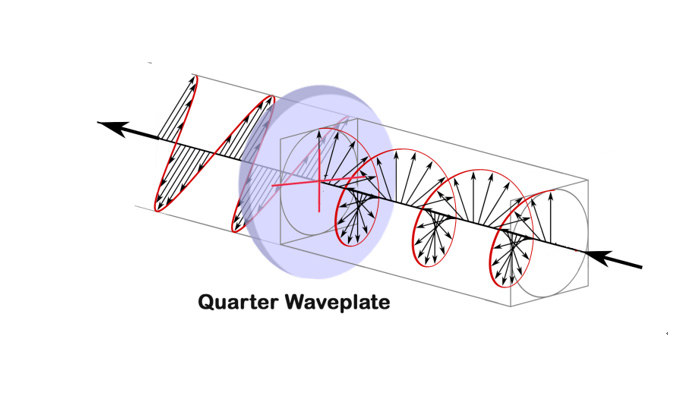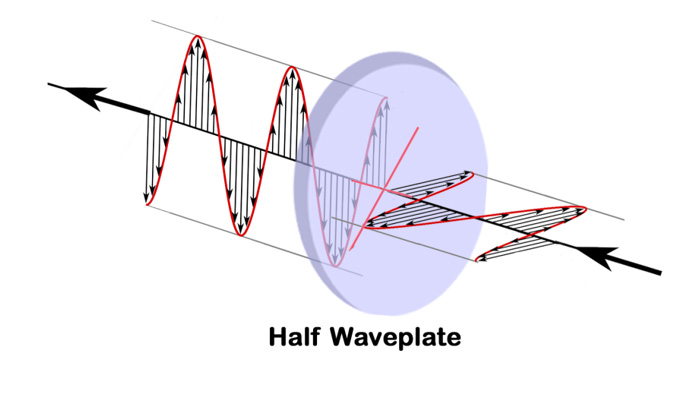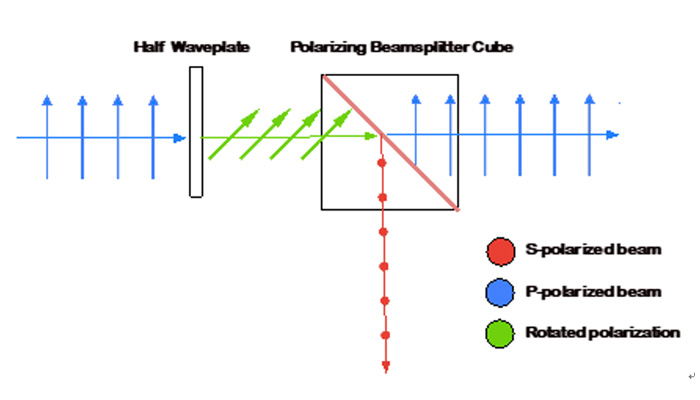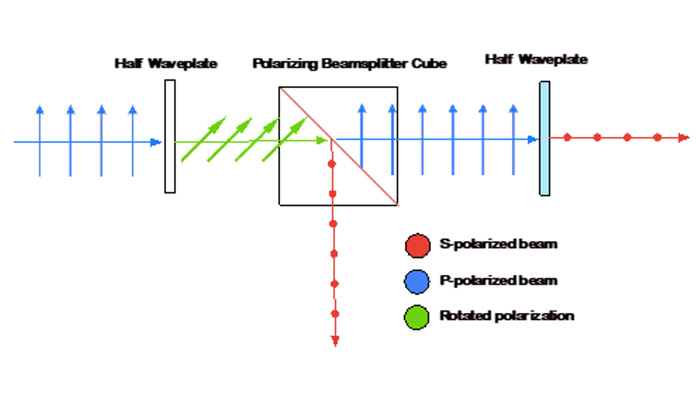

Time:2023-05-18 Source: Original Clicks:1586
Waveplates,
also known as retardation plates or phase shifters, are flat optical components
designed to manipulate the polarization state of light waves. They consist of a
birefringent material,which has different refractive indices for different
polarization directions.
When a polarized light wave enters a waveplate, it splits into two components, called the ordinary ray and the extraordinary ray, each of which travels at a different speed through the birefringent material. As a result, the two rays accumulate a relative phase shift that depends on the thickness and birefringence of the waveplate. Themost common types of waveplates are the quarter-waveplate and the half-waveplate.
A quarter-waveplate introduces a relative phase shift of π/2between the two polarization components, which converts linearly polarized light into circularly polarized light or vice versa.

A
half-waveplate introduces a relative phase shift of π, which rotates the
polarization direction of linearly polarized light by a certain angle.

Waveplates are
widely used in various optical applications, such as polarization control,
interferometry, microscopy,and spectroscopy. They can also be combined with
other optical elements, such as polarizers, lenses, and mirrors, to create more
complex optical systems.
Multiple order and zero order waveplatesare two types of waveplates that differ in their performance characteristics.
Zero
Order: Azero order waveplate is a waveplate that is designed to introduce
a specific phase shift (e.g., π/2 for a quarter-waveplate or π for a
half-waveplate) between the two polarization components of incident light,
without introducing any additional phase shifts. This means that the output
polarization state is purely a function of the input polarization state and the
waveplate's thickness and birefringence. Zero order waveplates are often
preferred in applications where high polarization purity and accuracy are
required, such as inpolarization-sensitive interferometry and polarimetry.
Standard Zero Order: A standard zero order waveplate is made by taking a birefringent material (such as quartz or magnesium fluoride) and cutting it to a specific thickness based on the desired phase shift (e.g., π/2 for a quarter-waveplate).
The thickness
is chosen to ensure that the phase difference between the two polarization
components of the incident light is exactly the desired value, and the
resulting waveplate is called a zero order waveplate. However, due to small
variations in the birefringent material,there can still be a small amount of
unwanted phase shift introduced, which can lead to some degree of polarization
distortion in the output light. This is referred to as residual birefringence.
True Zero
Order: A true zero order waveplate, on the other hand, is made by using a more
precise manufacturing process that minimizes the residual birefringence.One
method to achieve this is to use a birefringent material with a very small birefringence,
such as crystalline quartz, and to cut the material at a specific angle to the
crystal axis. This produces a waveplate with a much smaller residual
birefringence, resulting in a higher degree of polarization purity in the
output light.
Multiple
Order: A multiple order waveplate, on the other hand, is a waveplate that introduces
multiple phase shifts (i.e., integer multiples of the designed phase shift)
between the two polarization components of incident light. This occurs because
the thickness of the waveplate is not an exact multiple of the wavelength of
light, which causes the different wavelength components of the incident light
to accumulate different phase shifts.
Multiple order
waveplates are less expensive to manufacture than zero order waveplates and can
be used in many polarization control applications. However, they have some
drawbacks, including a lower polarization purity and a higher sensitivity to
wavelength and temperature changes.
Achromatic –
Achromatic waveplates consist of two different materials that practically
eliminate chromatic dispersion. Standard achromatic lenses are made from two
types of glass, which are matched to achieve a desired focal length while
minimizing or removing chromatic aberration. Achromatic waveplates operate on
the same basic principle. For example, Achromatic Waveplates are made from
crystal quartz and magnesium fluoride to achieve nearly constant retardation
across abroad spectral band.
Applications:
Lasers Applications:
1.Wavelength
combining and separation:Waveplates are used to manipulate the polarization of
light in laser systems to combine and separate different wavelengths of light. This
is useful in applications such as spectroscopy, where different wavelengths
need to be separated and detected separately, or in telecommunications where
different wavelengths are combined for high-speed data transmission.
2.Q-switching: Waveplates
can be used in Q-switching, a technique used to achieve extremely high pulse
powers in lasers. Q-switching involves rapidly switching the laser cavity from
a low-Q state to a high-Q state, which causes the stored energy to be released
in a short pulse. Waveplates can be used to control the polarization of light
in the cavity, which affects the Q-switching performance and pulse
characteristics.
3.Destructive
feedback quenching: In laser systems, destructive feedback can occur when
reflected light interferes with the laser beam and causes damage to the laser.
Waveplates can be used in to create and Optical Isolator to control
the polarization of the reflected light and prevent destructive feedback.
4. Circular
polarization in industrial laser cutting: Circularly polarized light can
be used in industrial laser cutting systems to achieve cleaner and more uniform
cuts. This is because circularly polarized light produces a more symmetric beam
profile and reduces the effects of beam distortion and scattering. Waveplates
can be used to convert linearly polarized light to circularly polarized light
in these systems.
Variable
Beamplitter: Avariable beamsplitter is a device that divides a beam of light
into two separate beams, with the amount of light split between them being
adjustable.It uses a polarizing beamsplitter cube and a half waveplate to
control the transmission (P polarized light) and reflection (S-polarized light)
inside the cube. By rotating the half waveplate, the polarization angle of the
incoming light can be modified, which adjusts the amount of light transmitted
through the beamsplitter versus the amount that is reflected. This provides
precise control over the output ratio of the beamsplitter.

If the
polarization of the two separated beams needs to be aligned on the same plane,
a half waveplate can be inserted into the path ofone of the output beams. By
adjusting the orientation of the waveplate, both beams can be polarized in the
same direction. This is crucial in applications where the beams need to form an
interference pattern, such as in recording a hologram or writing a holographic
diffraction grating.

Polarization
Cleanup: In some optical systems, multiple reflections from mirrors can cause
changes in the polarization state of light. When the plane of polarization of a
beam is aligned with or perpendicular to the plane of a mirror, there is
usually no change in polarization upon reflection. However, if the polarization
direction makes an angle with the plane of incidence,reflections from mirrors,
can cause small phase shifts between the parallel and perpendicular
polarization components. This can result in the reflected wavebeing slightly
elliptically polarized, which can be observed as degraded extinction when a
polarizer is inserted and rotated. To correct for this, a full waveplate can be
inserted and tilted slightly about either its fast orslow axes to adjust the
retardation and cancel out the ellipticity of the reflected wave.

Definitions and
Terminology:
Fast Axis:The
fast axis is the axis along which light travels with the higher velocity or lower
refractive index in a birefringence material. It is also known as
the"extraordinary axis" or "e-axis." Light polarized along
the fast axis will experience less delay or phase shift compared to light
polarized along the slow axis.
Slow Axis:The
slow axis is the axis along which light travels with the lower velocity or higher
refractive index in a birefringence material. It is also known as
the"ordinary axis" or "o-axis." Light polarized along the
slow axis will experience more delay or phase shift compared to light polarized
along the fast axis.
Birefringence: Birefringence
is a phenomenon in optics where a material exhibits different refractive
indices for light waves of different polarization states.This differential
refractive index causes light waves of different polarization states to refract
or bend at different angles as they pass through the material. As a result, a
single incident light wave can be split into two or more waves that propagate
with different velocities and directions, leading to double refraction or the
splitting of a light wave into two or more rays with different paths.
When
unpolarized light passes through a birefringent material, the different
refractive indices for different polarization states cause the incident light
to be separated into its parallel and orthogonal components, leading to the
phenomenon known as birefringent or birefringent interference. This can result
in the generation of interference patterns, or the polarization of light being
modified as it propagates through the birefringent material.
Retardation:Retardation
refers to the phase shift that occurs between the polarization component
projected along the fast axis and the component projected along the slow axis
of a waveplate. It can be specified in units of degrees, waves, or nanometers,
with one full wave of retardation being equivalent to 360°, half wave being
equivalent to 180° and a quarter being equivalent to wave 90°. In waves it
would be, 1λ, λ/2 and λ/4. In nanometers, λ represents the wavelength of light
in nanometers. For example, if the half waveplate is designed for use with
light of wavelength 532 nm, the retardation would be 0.5 * 532 nm = 266nm.
Retardation
values for most waveplates are λ/4, λ/2, and 1λ. However, other values can be
useful a phase shift may occur between optical components caused by an internal
reflection in one of the components. A compensating waveplate can be used to
restore the desired polarization.